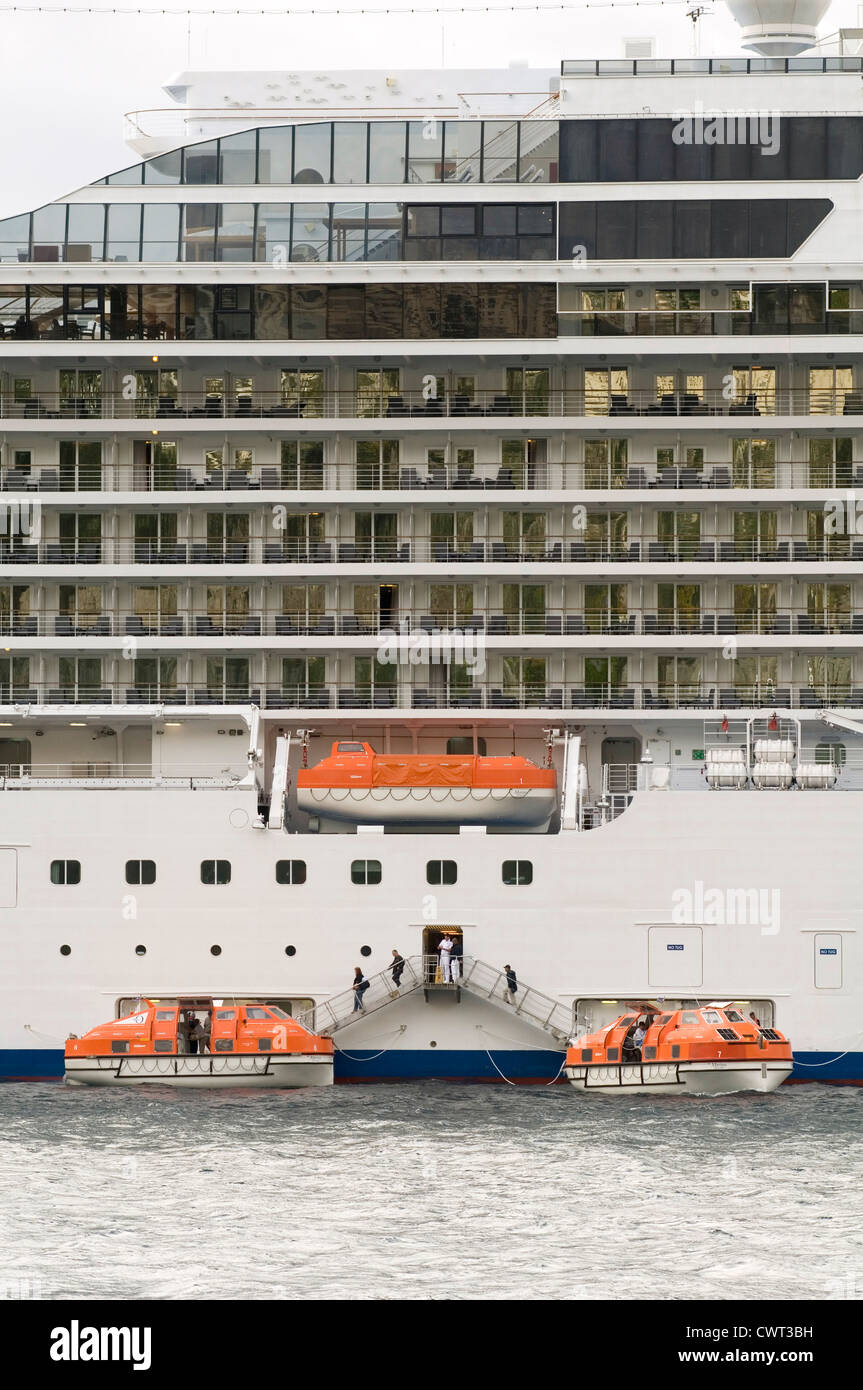Table Of Content
Not only do they serve as rescue vessels, they are also equipped with necessary survival supplies, from food and water to first aid kits, thermal protective aids, and distress signal devices. Lifeboats, therefore, represent an amalgamation of safety, survival, and rescue equipment, all bundled into a single, life-preserving entity. With sound design and training, crews can successfully evacuate passengers from even the largest ships using on-board lifeboats. Responsible crew members oversee loading passengers into lifeboats according to carefully planned procedures. The priority is getting boats lowered and away from the ship safely as quickly as possible. In addition to food and water, lifeboats also contain basic emergency equipment.
Lifeboat Maintenance and Testing
Training and drills play a crucial role in ensuring the crew and passengers are well-prepared for any situation that may arise regarding lifeboats. Inflatable life rafts on cruise ships are not meant to replace traditional lifeboats but to complement them. Typically, the standard lifeboat found on many cruise ships can hold around 150 passengers. This number ensures that, in the event of an emergency, passengers can be evacuated quickly and efficiently. Despite the LSA's 150-person capacity limit for lifeboats, an exception allows for larger lifeboats on some of the world's largest cruise ships. Another bit of good news is that there are more life rafts located on a ship than is necessary.
Training and Drills
Carnival says missing Houma man jumped from cruise ship - WGNO New Orleans
Carnival says missing Houma man jumped from cruise ship.
Posted: Tue, 14 Nov 2023 08:00:00 GMT [source]
Cruise ships do conduct lifeboat drills, and they are an essential aspect of the cruising experience. These drills are not just a nod to safety standards, but a foundational practice to ensure the wellbeing of every passenger and crew member on board. Once a lifeboat is delivered to the shipyard for installation on a ship, the inspections and tests do not stop.
Where Are The Lifeboats On a Cruise Ship?
The reasoning is straightforward – during an emergency evacuation like a sinking, having the capacity to get every single person safely off the ship as quickly as possible should be the goal. Disney Cruise Line was the first cruise line to have yellow lifeboats, instead of the traditional regulation orange. Coast Guard to paint the lifeboats yellow, to keep with the special colour theming of the ship. To ensure I stay charged and protected while on the go, it’s essential to invest in LifeProof accessories. LifeProof cases are designed to withstand various elements, but it’s important to have a reliable source of power to keep your phone alive. The slim design of LifeProof phone cases doesn’t add bulk to my phone while still providing protection from drops, water, snow, and more.
What type of cuisine can be expected in the main dining rooms?
In addition to partially enclosed lifeboats, cruise ships also carry lifeboat tenders. The lifeboat is then maneuvered alongside the ship and attached to the davit cables. The davit system hoists the lifeboat from the water, aligning it with the embarkation deck. Both these procedures – launching and recovering – are regularly practiced by crew members to ensure efficiency and safety. Cruise ships take extensive precautions to keep passengers safe, including carrying lifeboats and life rafts.
How Many Lifeboats Are There On A Cruise Ship?
These include provisions for survival at sea, such as emergency rations, fresh water, and appropriate signaling devices. Additionally, lifeboats must be equipped with propulsion systems or be designed to be easily maneuvered with oars, ensuring that they can be navigated to safety if the ship becomes incapacitated. Packed with essential gear and provisions, lifeboats become floating havens of safety and survival during emergency situations at sea. To ensure their effectiveness, lifeboat training is essential for all crew members. They must be well-versed in operating lifeboats, deploying them safely, and navigating to a designated rescue area.
Titanic sinking
In practice, most cruise ships have more than the minimum number of lifeboats required. For example, Royal Caribbean’s Wonder has passenger and crew capacities of 6,988 passengers and 2,300 crew for a total of 9288. It was not until after the sinking of RMS Titanic on April 15, 1912, that a broader movement began to require a sufficient number of lifeboats on passenger ships for all people on board. Titanic's gross tonnage of 46,000 tonnes was almost five times that which the Board of Trade lifeboat regulations were based on. Even though the 1,178 person capacity of its 20 lifeboats slightly exceeded the required 1,060, it still fell over 2,000 shy of the ship's maximum carrying load of 3,330 people.
You can expect nothing but the best when it comes to the onboard food quality with Royal Caribbean International. From sailing across pristine Caribbean waters to embarking on daring expeditions to far-flung destinations, he has amassed a treasure trove of first-hand experiences in the world of cruising. As passengers navigate the challenging circumstances, they can rest assured that the crew is trained to respond swiftly and effectively to any emergency. Now, let’s explore the evacuation procedures and protocols in place to ensure a smooth and orderly process. These can be manually deployed, but they are also capable of automatic deployment, both operations can take place even when heavily listing - another requirements in SOLAS. In the front center of the boat, above the diesel engine, there is the command console from where the boat’s pilot will ensure that everybody reaches safety.

Regular maintenance and testing of lifeboats are crucial for ensuring the safety of passengers and crew aboard cruise ships. The International Maritime Organization (IMO) has established guidelines and requirements for lifeboat maintenance, including the SOLAS. These regulations mandate the number, capacity, and design features of lifeboats on cruise ships, alongside stipulating regular maintenance, inspection, and drill protocols. Under SOLAS, it is required that all passenger ships have enough lifeboats on each side of the ship to accommodate at least 50% of the total number of people onboard. Modern cruise ship lifeboats reflect cutting-edge marine technology, focusing on increased capacity, enhanced safety features, and superior maneuverability. These vessels, although compact, are designed to comfortably accommodate a large number of passengers and ensure their survival during the precarious journey away from a distressed ship.
At the very least, in times of rough seas and large waves pounding the ship, it can be comforting to know there’s enough lifeboat capacity for everyone. Although it’s unlikely a cruise ship sinking or even capsizing, there are rare occasions when lifeboats may be needed. This attempted to be addressed by creating (or adding) separate lifeboat decks, and the wider use of collapsible lifeboats,[citation needed] a number of which had been carried on Titanic.
Moving on to the next section about passenger instructions and safety briefings, it is essential that every passenger pays close attention to the information provided. By having reliable communication systems and advanced navigational equipment, cruise ships can minimize the risk of accidents and ensure efficient rescue operations. These systems are essential for guiding lifeboats to safety during an evacuation. The remaining 25% of passengers that can't be accommodated in the traditional lifeboats can use cruise ship inflatable life rafts. These are generally designated for crew members, while guests will board the lifeboats first — though rafts can also be used for guests if necessary.
Modern cruise ships already dedicate large amounts of deck space to existing boats and rafts. According to some maritime safety advocates, cruise ships should have enough lifeboats for 100% or more of the people on board. These SOLAS lifeboat requirements provide an important emergency evacuation minimum for the massive populations onboard cruise ships. But as we’ll see next, some industry experts argue even more capacity is needed. Rafts are temporary habitats until passengers can transfer to lifeboats or be rescued.
In addition, the crew undergoes extensive training to ensure that they know how to operate the lifeboats efficiently. They’re trained to handle any emergency situation that may arise and to ensure the safety of all passengers on board. As a lover of history, delving into the regulations surrounding life-saving equipment on board ships is a fascinating journey through time. The sinking incidents of the Titanic and other ships led to the creation of the International Convention for the Safety of Life at Sea (SOLAS) in 1914. This convention overhauled safety regulations on lifeboats and ensured that all ships had enough life-saving equipment on board.
New megaships have adopted the use of larger lifeboats that can accommodate 370 people, which means that fewer lifeboats are needed in order to meet the required capacity. However, these days a cruise ship’s lifeboats can be multipurpose — used to ferry passengers to the port as necessary. And, as cruise ships have grown bigger and bolder, this has carried over to the lifeboats in some instances.
In this article, we will explore the intricate calculations and considerations behind determining how many lifeboats are required on a cruise ship. I appreciate the amenities offered in the lifeboats, such as the food rations and fresh water, but I know their primary purpose is for life-saving. Comfort is not a priority in a lifeboat, as it’s designed to keep you alive until rescued.

No comments:
Post a Comment